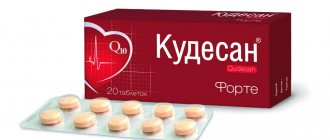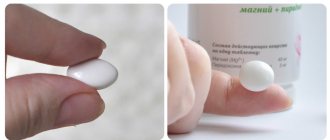Release form and composition
Dosage form – film-coated tablets: oval, biconvex, with a slightly glossy surface, white or almost white, almost odorless, with “A83” engraved on one side; on a cross section, almost white or white (15 pieces in a blister, 2, 4 or 6 blisters in a cardboard pack).
Composition of Panangina Forte (1 tablet):
- active ingredients: potassium aspartate (in the form of hemihydrate) – 316 mg, magnesium aspartate (in the form of tetrahydrate) – 280 mg;
- auxiliary components: colloidal silicon dioxide, magnesium stearate, potato starch, talc, povidone K30, corn starch;
- shell: macrogol 6000, butyl methacrylate copolymer, talc, titanium dioxide (color index: CI 77891, E 171).
Dosage
Pills
Take 1-2 tablets. three times a day, but no more than 3 tablets at a time, after meals, because Empty stomach contents reduce the effectiveness of the drug.
The duration of use and the need for repeated applications are determined individually.
Injections
Used intravenously, by drip, as a slow infusion (~20 drops per minute): the drug from 1-2 ampoules is dissolved in 50-100 ml of glucose or dextrose solution 5%. Combination treatment with Panagin with other drugs with intravenous administration is possible.
Repeated administration - no earlier than 4-6 hours after the first dropper.
Pharmacological properties
Pharmacodynamics
Potassium (K+) and magnesium (Mg++) cations are the most important intracellular positively charged ions that play a key role in the functioning of numerous enzymes, the formation of connections between intracellular structures and macromolecules, as well as in the mechanism of muscle contractility. The extra- and intracellular ratio of magnesium, potassium, sodium and calcium ions affects myocardial contractility.
Endogenous aspartate acts as an ion conductor, having a high affinity for cells. Due to the slight dissociation of its salts, ions penetrate into the cell in the form of complex compounds. Potassium aspartate and magnesium aspartate improve myocardial metabolism. Accordingly, a lack of potassium and magnesium predisposes to the development of metabolic changes in the myocardium, arrhythmia, atherosclerosis of the coronary arteries, and arterial hypertension.
Pharmacokinetics
Potassium aspartate and magnesium aspartate, which are part of Panangin Forte, are intensively absorbed in the intestine, mainly in the small intestine. Excreted by the kidneys.
Differences between “Panangin” and its “Forte” form: what is the difference?
The main difference between “Panangin Forte” and “Panangin” is the dosage of potassium and magnesium aspartate in tablets.
Comparison of the concentrations of these elements:
| Active substance | "Panangin" | "Panangin Forte" |
| Magnesium aspartate salt | 175 mg | 350 mg |
| Potassium aspartate salt | 166 mg | 332 mg |
Additionally, there are differences in the packaging of the tablets. The ordinary “Panangin”, which is produced by pharmaceuticals in Hungary, is packaged in jars of 50 tablets. They are convenient to carry with you in your purse or pocket. "Panangin Forte" is packaged in classic blisters of 15 tablets. The pack contains 30, 60 or 90 tablets.
The cost of a package of Panangin Forte is on average 50% higher than the standard dosage.
It should be noted that a cheap substitute for the drug “Asparkam” has a similar active ingredient, but in a lower concentration (175 mg each of K+ and Mg2+ aspartate).
Contraindications
- hypermagnesemia;
- hyperkalemia;
- acute and chronic renal failure;
- state of dehydration;
- acute metabolic acidosis;
- violation of amino acid metabolism;
- hemolysis;
- myasthenia gravis;
- shock, including cardiogenic (blood pressure less than 90 mm Hg);
- atrioventricular block I–III degree;
- Addison's disease;
- age under 18 years;
- hypersensitivity to any component of the drug.
Panangin Forte should be used with caution during pregnancy (especially the first trimester) and breastfeeding.
Brief instructions for use of the drug
K+ and Mg2+ are a “metabolic tandem” that supports most of the energy processes in the human body.
Potassium ions are responsible for the transmembrane action potential, maintaining the excitability of neuromuscular fibers, impulse transmission and myocardial contractility.
Mg2+ is a physiological antagonist of Ca2+ ions, the main part of which is contained in the intracellular fluid.
The regulation of the content of these microelements in tissues is ensured by the excretory function of the kidneys.
Normally, the same amount of electrolytes is excreted from the human body per day as it comes from food.
Magnesium ions regulate:
- processes of energy generation and tissue regeneration;
- immune reactions;
- functioning of the cardiac conduction system;
- metabolism of cholesterol, proteins, purine bases;
- platelet aggregation capabilities;
- synthesis of adenosine triphosphate – the main cellular “fuel”;
- detoxification functions of the liver, breakdown of glycogen;
- function of relaxation of the vascular wall.
Causes of potassium-magnesium deficiency:
- various cardiovascular pathologies;
- changes in diet (unbalanced diet, protein diet, high Ca2+ intake);
- excessive consumption of table salt (sodium chloride);
- uncontrolled use of sorbents, laxatives;
- alcohol abuse;
- diabetes mellitus type II;
- dysfunction of the parathyroid glands;
- malabsorption in the small intestine;
- hereditary kidney diseases;
- severe or prolonged diarrhea, vomiting;
- therapy with medicinal substances (insulin, bronchodilators, Verapamil, loop diuretics, mineralocorticoids, Penicillin, aminoglycoside antibiotics, etc.).
In the Panangin Forte preparation, K+ and Mg2+ are present in the form of aspartate salts (a universal conductor of ions into the cell cytoplasm with a high degree of endogenous affinity, which improves membrane permeability for electrolytes under conditions of oxygen starvation). This form of the active substance quickly compensates for the intracellular deficiency of microelements.
The drug has antiarrhythmic and antihypoxic effects. By activating Na+-K+-ATPase, which is responsible for the flow of potassium and sodium through the cell membrane, the drug increases the excitation threshold and reduces the speed of nerve impulses in the myocardium.
Indications for use of Panangina Forte:
- as a component of combined treatment of circulatory failure, angina pectoris, atherosclerosis, in the acute period of myocardial infarction, in patients with ventricular arrhythmias;
- high cardiac risk in patients with comorbid conditions (hypertension, coronary heart disease, endothelial dysfunction, cardiosclerosis, diabetes mellitus);
- long-term use of digitalis preparations (Digoxin, Strophanthin) to prevent glycoside intoxication;
- cardiopsychoneurosis;
- enriching the diet during a diet or when it is impossible to eat properly.
The drug is almost completely adsorbed in the gastrointestinal tract and immediately takes part in metabolic processes. The kidneys are primarily responsible for excretion.
Contraindications to the use of Panangina Forte:
- allergy to the constituent substances in the medication;
- acute or chronic renal failure;
- Addison's disease;
- AV block of the third degree;
- cardiogenic shock (blood pressure below 90 mm Hg).
The drug should not be prescribed to patients taking potassium-sparing diuretics, ACE inhibitors, Cyclosporine, direct anticoagulants, non-steroidal anti-inflammatory substances (hyperkalemia develops during treatment).
Some medications slow down the absorption of potassium and magnesium from the small intestine (tetracycline antibiotics, iron supplements), so an interval of at least three hours must be maintained between taking such medications.
Panangin Forte should be used with caution in patients:
- with miasthenia gravis;
- with extensive skin damage from burns;
- with acute dehydration;
- with gastrointestinal ulcer.
Even after taking high doses of potassium and magnesium aspartates, no symptoms of poisoning were observed. Hyperkalemia develops only in patients with impaired renal excretory function.
Possible development of adverse reactions:
- diarrhea;
- general asthenia;
- paresthesia;
- decreased heart rate;
- ventricular arrhythmias;
- vomiting;
- drowsiness;
- lowering blood pressure.
Recommendations for use of "Panangin Forte"
The routine dosage of the drug is a tablet three times a day. If necessary, the quantity can be increased to 2 x 3 times per day.
Hydrochloric acid of the stomach reduces the bioavailability of the drug components. Therefore, it is recommended to take the medicine during or after meals.
The course of taking Panangina Forte is selected for each case individually, taking into account a number of factors.
Side effects
During the period of taking Panangin Forte, the following undesirable reactions were observed in certain cases:
- diarrhea, nausea, vomiting, burning or discomfort in the epigastric region (in patients with cholecystitis and anacid gastritis);
- paradoxical reaction (increase in the number of extrasystoles), atrioventricular block;
- hypermagnesemia (feeling of thirst, hyporeflexia, facial flushing, respiratory depression, decreased blood pressure, convulsions);
- hyperkalemia (diarrhea, nausea, vomiting, paresthesia).
In what cases is it better to choose Panangin Forte?
The drug is positioned as one that can be used without a doctor’s prescription and even as a supplement to dietary nutrition. The daily requirement for potassium for an average person ranges from 300-350 mg, for magnesium – 350-400.
Often, K+ and Mg2+ deficiency are interrelated. Magnesium deficiency aggravates the manifestations of hypokalemia, especially in patients who are forced to constantly take loop diuretics, causing refractoriness to treatment with drugs containing only potassium.
Due to the Mg2+ depot, its deficiency may not be detected in bone tissue according to clinical tests (normal plasma concentration). But only 75% of the population receives this microelement from food in sufficient quantities.
Magnesium deficiency is found in 90% of patients who have suffered cardiac events, which is aggravated in the acute period of myocardial infarction.
With age, the adsorbing capacity of the small intestine decreases, and in parallel, the need for K+ and Mg2+ increases.
When there is a deficiency of these electrolytes in the body, the following occurs:
- decreased muscle tone;
- disruptions in cardiac activity (increasing tendency to arrhythmias);
- increased blood pressure;
- depression;
- paresthesia;
- chronic fatigue.
In patients with chronic cardiovascular pathologies, potassium-magnesium deficiency aggravates the course of the disease and increases the likelihood of complications.
According to the literature, taking Panangin Forte is recommended:
- all patients over 45 years of age without renal impairment;
- athletes, people actively involved in fitness;
- workers of heavy physical labor;
- people who often visit the sauna;
- people who constantly adhere to diets, have restrictions in their daily diet, and use herbal teas for the purpose of losing weight;
- women taking birth control pills;
- patients with arterial hypertension (as prescribed by a doctor);
- those taking glucocorticoids, loop diuretics, sedatives;
- patients with diabetes mellitus, widespread atherosclerosis, hypercholesterolemia;
- people suffering from cramps and pain in the calf muscles;
- patients constantly taking enzyme preparations, medications to improve gastrointestinal motility.
Overdose
If the recommended dose of Panangin Forte is significantly exceeded, the likelihood of developing hypermagnesemia and hyperkalemia increases.
Symptoms of hypermagnesemia:
- nausea, vomiting;
- decreased blood pressure;
- decreased neuromuscular excitability;
- lethargy.
With a sharp increase in the content of magnesium ions in the blood, depression of deep tendon reflexes, respiratory paralysis, and coma are possible.
Symptoms of hyperkalemia:
- confusion;
- increased fatigue;
- paresthesia;
- myasthenia gravis;
- heart rhythm disturbances (arrhythmia, atrioventricular block, bradycardia, cardiac arrest).
Treatment of overdose is symptomatic; Calcium chloride (100 mg/min) is administered intravenously. If necessary, hemodialysis is performed.
special instructions
Patients with diseases accompanied by hyperkalemia should be under special supervision. It is necessary to regularly monitor the level of potassium in the blood plasma.
Impact on the ability to drive vehicles and complex mechanisms
No special studies have been conducted, however, taking into account the pharmacokinetic parameters of Panangin Forte, the drug is not expected to have a negative effect on the ability to operate complex mechanisms and vehicles, as well as perform other work that requires increased attention, speed of mental and physical reactions.
conclusions
“Panangin Forte” has established itself in the Russian pharmaceutical market as an affordable, high-quality and easy-to-use drug for maintaining electrolyte balance.
But it is worth considering that its use cannot cure diseases of the heart, nervous or endocrine system, but only supplement the drug complex for adequate correction of the resulting conditions.
Patients with impaired excretory function of the kidneys and adrenal glands, arterial hypertension should definitely consult a doctor before using Panangin Forte.
Drug interactions
The risk of developing hyperkalemia (up to arrhythmia and asystole) increases with the combined use of non-steroidal anti-inflammatory drugs, angiotensin-converting enzyme inhibitors, heparin, cyclosporine, beta-blockers, potassium-sparing diuretics (for example, spironolactone, triamterene).
Panangin Forte enhances the negative batmo- and dromotropic effects of antiarrhythmic drugs.
With the simultaneous use of suxamethonium, decamethonium, succinyl chloride, atracuronium, neuromuscular blockade may be enhanced.
Calcium supplements reduce the effectiveness of magnesium.
Calcitriol increases plasma magnesium levels.
Anesthetics increase the inhibitory effect of magnesium on the central nervous system.
Magnesium reduces the severity of the action of tetracycline, streptomycin, polymyxin B and neomycin.
Potassium reduces the undesirable effects of cardiac glycosides.
Glucocorticosteroids eliminate hypokalemia caused by potassium supplements.
Enveloping and astringent drugs reduce the absorption of Panangin Forte in the gastrointestinal tract, so 3-hour intervals should be observed between their doses.
Indications for use
Pills
- Replenishing the lack of magnesium and potassium when their content in the diet is insignificant. The use of the drug for this purpose acts as a factor in the prevention of cardiovascular diseases and the development of complications of existing cardiovascular pathologies.
Solution
- Complex treatment of cardiac failure, rhythm disturbances (mostly ventricular arrhythmias and conditions due to excessive doses of cardiac glycosides), acute myocardial infarction.
- Improving the tolerability of drugs from the group of cardiac glycosides.










